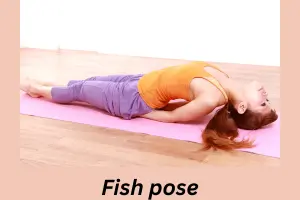Introduction
Matsyasana, also known as Fish Pose, is a reclining backbend yoga posture that is known for opening the heart and throat, stretching the chest, and strengthening the back.
The name “Matsyasana” comes from the Sanskrit words “Matsya,” meaning fish, and “asana,” meaning pose.
According to Hindu mythology, Lord Vishnu transformed into a fish to save humanity from a great flood, and this pose is said to provide buoyancy, just like a fish in water.

Matsyasana is commonly practiced to counterbalance the effects of forward bends or intense shoulder postures.
It’s especially beneficial for relieving stiffness in the upper body, improving respiratory function, and enhancing spinal flexibility.
This heart-opening pose is also deeply calming and helps reduce stress and fatigue, making it an excellent addition to a balanced yoga practice.
Steps to Perform Matsyasana (Fish Yoga Pose)
- Begin by Lying Down: Start by lying flat on your back with your legs extended and arms resting alongside your body. Make sure your entire back is resting comfortably on the mat.
- Tuck Your Arms Beneath You: Slide your hands, palms down, under your hips. Tuck your arms close to your sides, ensuring that your elbows point slightly outward to assist in lifting your chest later.
- Lift Your Chest: Inhale deeply and press your forearms and elbows into the floor, gently arching your upper back and lifting your chest toward the ceiling. Keep the back of your head lightly on the floor, creating a graceful backbend that stretches the throat and chest.
- Rest the Crown of the Head: Allow the crown of your head to touch the mat lightly. Your neck should form a gentle curve, and you should avoid placing any weight or strain on your head or neck.
- Engage the Legs: Keep your legs active and press your thighs and toes slightly down into the floor. Your feet can remain relaxed, but ensure that your legs are aligned and extended straight.
- Hold and Breathe: Hold the pose for 30 seconds to 1 minute, focusing on deep, steady breaths. With each inhale, feel your chest expand, and with each exhale, relax deeper into the stretch.
- Release the Pose: To come out of the pose, gently lower your chest and head back onto the mat, release your arms from under your hips, and relax your body. You can hug your knees to your chest to counterbalance the backbend before moving on to your next posture.
Benefits of Matsyasana (Fish Yoga Pose)
- Improves Posture: Matsyasana opens the chest and stretches the shoulders, counteracting the effects of slouching, poor posture, and long hours of sitting.
- Relieves Respiratory Issues: The deep chest opening improves lung capacity and encourages deeper breathing, making this pose beneficial for those with asthma, bronchitis, and other respiratory conditions.
- Stimulates the Throat Chakra: By stretching the throat and neck, Matsyasana stimulates the throat chakra (Vishuddha), promoting clear communication and self-expression.
- Strengthens the Back and Neck: The gentle backbend in Matsyasana strengthens the upper back muscles and the muscles along the spine, reducing stiffness and discomfort.
- Alleviates Fatigue and Stress: Matsyasana promotes relaxation and is excellent for relieving stress, fatigue, and mild anxiety. It helps balance emotions by releasing tension stored in the chest and shoulders.
- Increases Energy Levels: This heart-opening posture activates energy flow in the body, revitalizing the body and mind, and helping combat feelings of lethargy.
- Stimulates Digestive Organs: The gentle arch in the back helps massage and stimulate the abdominal organs, improving digestion and helping to relieve bloating or indigestion.
- Stretches the Hip Flexors: Matsyasana gently stretches the hip flexors and front of the thighs, which is beneficial for people who experience tightness from prolonged sitting or physical activity.
- Helps Balance Hormones: The stretch in the throat stimulates the thyroid and parathyroid glands, which regulate hormones and metabolism in the body.
Precautions and Contraindications of Matsyasana (Fish Yoga Pose)
- Neck or Spine Injuries: Individuals with neck, spine, or back issues should avoid Matsyasana or perform it with caution. If the neck feels strained, it is advisable to use a block or folded blanket under the head for support.
- High or Low Blood Pressure: Those with high or low blood pressure should approach Matsyasana carefully, as the pose can alter blood circulation, especially in the head and neck area.
- Heart Conditions: Due to the chest opening, those with heart conditions should consult a doctor or yoga instructor before attempting this pose.
- Migraine or Vertigo: People suffering from migraines or vertigo should avoid Matsyasana, as the neck arch and head position can exacerbate symptoms of dizziness or headaches.
- Spondylitis: Individuals with cervical spondylitis or other spinal conditions should avoid Matsyasana or use a modified version, such as keeping the head supported on the floor without the full backbend.
- Pregnancy: Pregnant women, particularly in the later stages, should avoid Matsyasana due to the pressure on the abdomen and chest. Modifications can be made by using props for support, but consultation with a healthcare provider is essential.
- Severe Back Pain: If you experience significant discomfort in your lower or upper back, it is best to avoid this pose, as the backbend can exacerbate the issue.
- Hernia or Abdominal Conditions: Since the pose gently compresses the abdominal area, those with hernias or severe abdominal issues should refrain from practicing this pose without medical advice.
Conclusion
- Fish Yoga Pose is a deeply restorative yoga pose that offers a wide range of physical, emotional, and mental benefits.
- By opening the chest, stretching the throat, and strengthening the back, it provides relief from poor posture, respiratory issues, and stress.
- It is an energizing pose that promotes emotional release, balances energy flow and enhances overall vitality.
- Regular practice of this pose can help increase flexibility, strengthen muscles, and improve digestion, making it a valuable addition to your yoga routine.
- However, like all yoga poses, it is essential to approach Matsyasana with care and respect for your body’s limitations.
- Practitioners should be mindful of neck and spine alignment to avoid strain or injury.
- Modifications with props such as blocks or cushions can be used to ensure comfort and safety.
- When practiced mindfully, Matsyasana can help foster a sense of openness, relaxation, and peace, making it an excellent tool for enhancing both physical health and emotional well-being.
